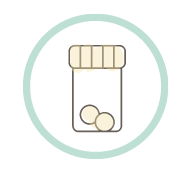 Because every patient with bronchiectasis is different, the symptoms experienced from a chronic lung condition can vary widely. For clinicians, this presents the challenge of choosing a bronchiectasis treatment that is most effective in allowing patients to live a healthier, fuller life—without the physical and financial stress of ongoing hospitalization and emergency room visits.
Because every patient with bronchiectasis is different, the symptoms experienced from a chronic lung condition can vary widely. For clinicians, this presents the challenge of choosing a bronchiectasis treatment that is most effective in allowing patients to live a healthier, fuller life—without the physical and financial stress of ongoing hospitalization and emergency room visits.
Though bronchiectasis remains an underdeveloped area of study, various treatments are emerging to improve many of the symptoms associated with bronchiectasis. To help patients understand the different approaches to treating bronchiectasis, we’ve included an overview on some methods currently being prescribed by clinicians today.
Treating Bronchiectasis with Antibiotics and Medications
 According to the American Lung Association, prescribers may choose to treat bronchiectasis-related symptoms using a combination of antibiotics and other medications.
According to the American Lung Association, prescribers may choose to treat bronchiectasis-related symptoms using a combination of antibiotics and other medications.
Bronchiectasis is caused by recurring inflammation and infections in a person’s airways. Antibiotics help combat infection and can be administered in three ways: (1) orally, (2) intravenously, or (3) inhaled.[i] Doctors may administer antibiotics intravenously to help treat respiratory infections that require hospitalization. In contrast, a clinician may prescribe antibiotics through a nebulizer for preventative maintenance care.[ii]
In addition to antibiotics, clinicians may also prescribe medications designed to thin mucus, such as acetylcysteine, or bronchodilators, which help widen the airways. Both treatments can be used to help patients manage flare ups from mucus build up by making it easier to cough up.[iii]
Treating Bronchiectasis with Airway Clearance Therapy
 Airway clearance techniques can be administered manually, through a hand-held device, or by using a respiratory vest. Airway clearance techniques, including chest physiotherapy, help loosen mucus in the lungs so it is more easily coughed out.
Airway clearance techniques can be administered manually, through a hand-held device, or by using a respiratory vest. Airway clearance techniques, including chest physiotherapy, help loosen mucus in the lungs so it is more easily coughed out.
The American Thoracic Society offers a comprehensive breakdown of the different airway clearance techniques your doctor may prescribe to help manage your bronchiectasis symptoms[iv]:
- Breathing techniques, such as huff cough
- Manual chest physiotherapy
- High Frequency Chest Wall Oscillation (HFCWO) Therapy
- Hand-Held Positive Expiratory Pressure (PEP) device
Though all airway clearance techniques may help patients clear their airways, HFCWO Therapy offers an effective, long-term solution to managing bronchiectasis symptoms by helping prevent recurring flare ups and improving overall quality of life.[v]
Through the use of an inflatable respiratory vest, pulses of air repeatedly squeeze and release the patient’s upper body, which helps to thin mucus and propel it towards major airways where it can be more easily coughed out. This type of airway clearance treatment is performed independently (without the aid of a caregiver or respiratory therapist) in the comfort of a patient’s home.
To learn more about treating bronchiectasis with HFCWO Therapy, watch this video featuring Dr. Frederic Seifer, board-certified pulmonologist.
Other Methods for Treating Bronchiectasis
 Treating Bronchiectasis with Surgery
Treating Bronchiectasis with Surgery
Doctors may recommend surgery to treat bronchiectasis and prevent a worsening of symptoms. According to the National Heart, Lung, and Blood Institute, this treatment method is used in rare occasions. For instance, when other treatments have failed to provide relief and only a small portion of the patient’s airways are affected by the disease, surgery may be considered a viable option.[vi] Therefore, your doctor may recommend removing part of the affected airway or part of the lung (or even a single lung) to prevent the spread of the disease.[vii]
Treating Bronchiectasis with a Lung Transplant
 Similar to treating bronchiectasis by surgery, doctors may—on rare occasions—suggest lung transplantation for individuals who have very severe lung disease and no other treatment options.[viii]
Similar to treating bronchiectasis by surgery, doctors may—on rare occasions—suggest lung transplantation for individuals who have very severe lung disease and no other treatment options.[viii]
A recent article published in BMC Pulmonary Medicine chronicles a 2018 study on the effectiveness of lung transplantation to increase the survival rate of patients living with severe end stage non-cystic fibrosis bronchiectasis. The findings revealed improvements in lung function and survival rates after receiving the transplant, with most patients testing negative for future infections (over a five year period).
Though there are multiple methods for treating bronchiectasis, the outcome will depend on the severity of your condition and how your body reacts to certain medications and treatments.
To learn more about bronchiectasis, its symptoms, and effective airway clearance devices, such as The SmartVest Airway Clearance System, a HFCWO therapy device that works to help patients manage their chronic symptoms and prevent recurring inflammation and infection, contact Electromed today!
[i] American Lung Association. “Diagnosing and Treating Bronchiectasis.” Retrieved from https://www.lung.org/lung-health-and-diseases/lung-disease-lookup/bronchiectasis/diagnosing-and-treating.html
[ii] British Lung Institute. “Treatment for Bronchiectasis.” Retrieved from https://www.blf.org.uk/support-for-you/bronchiectasis/treatment
[iii] National Heart, Lung, and Blood Institute. “Bronchiectasis.” Retrieved from https://www.nhlbi.nih.gov/health-topics/bronchiectasis
[iv] American Thoracic Society. Treating Bronchiectasis. Retrieved from https://www.thoracic.org/patients/patient-resources/resources/bronchiectasis.pdf
[v] Bronchiectasis News Today. High Frequency Chest Wall Oscillation. Retrieved from https://bronchiectasisnewstoday.com/high-frequency-chest-wall-oscillation-hfcwo/
[vi] National Heart, Lung, and Blood Institute. “Bronchiectasis.” Retrieved from https://www.nhlbi.nih.gov/health-topics/bronchiectasis
[vii] Chest Foundation. “Diagnosing and Treating Bronchiectasis.” Retrieved from https://foundation.chestnet.org/patient-education-resources/bronchiectasis/
[viii] Bronchiectasis News Today. “Lung Transplant Can Benefit Patients with Severe Bronchiectasis Study Finds.” Retrieved from https://bronchiectasisnewstoday.com/2018/06/07/lung-transplant-can-benefit-severe-bronchiectasis-patients-study/

